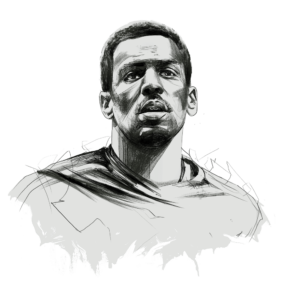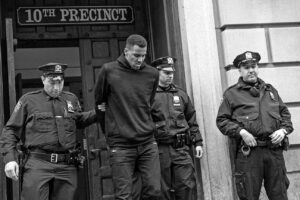On an April night in New York City, the Hawks forward was injured and arrested by the NYPD. This is the exclusive story of how, in the aftermath, he became what he never wanted to be: a civil rights symbol.

ive minutes and 22 seconds after Thabo Sefolosha came out onto the sidewalk from a Manhattan nightclub on the morning of April 8, his wrists were manacled behind his back and two policemen were steering him by his elbows toward the rear seat of a cop car.
In the days, weeks and months to follow, Sefolosha, a Swiss native of South African descent and a key player for the Atlanta Hawks, would retell the story of those five minutes over and over again — to his lawyer, his wife, his parents, his coaches, his teammates, the media, the jury, himself. In his memory, it doesn’t seem like five minutes. It doesn’t seem to him anymore like a space of time at all. It’s as if those five minutes won’t ever end. “There has honestly not been a day I haven’t thought about that night since it happened,” he says. “There’s no escaping from it.”
The team’s plane had landed in New York around 1:30 a.m. for a game against the Brooklyn Nets. Earlier that night, in Atlanta, Sefolosha had played 20 minutes against the Phoenix Suns in the nastiest, most belligerent game of the season. There were seven technical fouls. A Suns player was ejected. Now, at the Ritz-Carlton hotel in lower Manhattan, where the team was staying, Sefolosha didn’t feel like sleeping; he was too amped up. When he’d talked recently over the phone to his brother in Switzerland, he’d told him he was excited for the playoffs, which were starting in 10 days. He’d been to the NBA Finals once before, with the Thunder three years earlier, losing in five games to the Heat. Now, playing off the bench for the Hawks, who had clinched the top seed in the Eastern Conference, he wanted another chance at a title. He was a month from turning 31, old for the NBA. Who knew how many more opportunities he’d have. “Man, I’ve never felt like this,” he said to his brother. “We have a real shot. I’m going to give it all I got. I’m going to be a locomotive.”
A friend of Sefolosha’s, a sports agent living in New York who represents other NBA players, had texted, suggesting they meet at a place called 1 Oak in the city’s Chelsea neighborhood. Sefolosha had heard of the club — the kind of high-end, velvet-rope establishment that paparazzi encamp outside of in hopes of DiCaprio sightings — but he’d never been there. Sefolosha’s friend and teammate, Pero Antic, decided to go along. The club was becoming packed. They took a VIP table. At such tables, the only choice is to buy full bottles of liquor. They ordered one of Jameson and one of vodka. Sefolosha mixed his Jameson with Sprite; he had two or three of these. They got to talking with other clubgoers, whom they urged to pour themselves drinks from the bottles; there was no way Antic and Sefolosha could finish them. An hour passed. His friend the agent rose to say good night, and not long after he left, the house lights came blazing on and the music died. Everyone had to go, the bouncers said, giving no reason, and they all went, exiting orderly through the front door.
Emerging onto the street, they could see to the left what appeared to be a crime scene. Dome lights rotated atop police cars and emergency vehicles. There was a length of yellow tape and many uniformed cops shouting Clear the block! Everyone was being herded to the right, away from the yellow tape, down 17th Street toward its intersection with 10th Avenue, about 40 yards west of 1 Oak. Despite the cops’ instructions, people were coming out of the club and mingling in little groups on the sidewalk and in the traffic-blocked street, including Antic and Sefolosha, as can be seen in CCTV surveillance videos. People they’d met at their table were wishing them well in the playoffs. Someone said, “Bonne chance.” Sefolosha found himself talking to two women he’d met at the table that night, one of whom, he’d learned, had dated a current Hawk.
Now Sefolosha and Antic registered one cop in particular. He had a high-and-tight Marine Corps haircut. He was 5-foot-7. He was, according to witnesses, shouting: “Get the f— off my street.”
“Get the f— off my street,” the cop said again.
Antic is a bald 6-11 Macedonian, close to 300 pounds, with a dense black beard and a voice like a contrabassoon. A friend once described him as “resembling Xerxes,” the ancient Persian warlord. He tends to stand out in a crowd. Yet the cop seemed now to be focused solely on Sefolosha, according to the court testimony of a 1 Oak bouncer and that of the two women Sefolosha had met at the club. Standing 6-7 and wiry to the point of fatlessness, with a triangular face accentuated by a faint goatee, Sefolosha was wearing black jeans and a black hoodie. He wore the hood up. Sefolosha now said to the cop something along the lines of: “Relax, man. We’re going.” He and his group reached 10th Avenue. Many things were now happening at once. There was a livery cab, a black SUV, parked on 10th right at the corner. The driver asked whether anyone needed a ride. Sefolosha said yes. At one point Antic had wandered off from Sefolosha, but now here he was again, saying he’d found out that Chris Copeland, the Indiana Pacers forward, had just been stabbed. Outside the club! That’s what the crime scene back there was for! Could Sefolosha believe it? And now, according to trial witnesses, the one cop seemed to be in a rage. He’d told them to move; why were they still lingering? Get the f— out of here. Sefolosha said something back. He recalls lines of dialogue, largely corroborated by other witnesses. “You can talk to people nicely, it works just as well.” And: “It’s because you have a badge that you’re a tough guy.”
“With or without a badge,” the cop replied, “I’ll f— you up.” (Much later, when the officer was asked under cross-examination whether he had uttered these lines, he said, “I do not recall.”)
Sefolosha did not back down. “C’mon, man. You’re 5-foot-2. You’re a midget, man. Relax. I guess I’d be mad too if I were a midget.”
The cop seemed to move away. Other officers were urging Sefolosha and Antic to get into the SUV, to leave immediately. One cop, by his own account, was even holding its door open. Sefolosha muttered that he didn’t understand why he was being chased off so aggressively — many others were milling around at that same moment — and he couldn’t resist another crack. “I pay my taxes,” he said. “Matter of fact, they probably pay your salary.” Then, just before he was about to duck into the SUV’s back seat, a man approached.
“Yo, you gonna help a brother out?”
Sefolosha recognized him from earlier, when he and Antic first walked through 1 Oak’s ropes. He seemed to be a panhandler who worked the area. Sefolosha had refused the man’s earlier entreaty, but now he peeled a twenty from his billfold. According to Sefolosha, he made a point of saying out loud: “I’m going to give this guy some money.” He never got the chance. As can be seen on the CCTV video of the scene, the cop at the door of the SUV took the man by the arm and ushered him away. Irritated, intent now on pressing the bill into the man’s hand, Sefolosha took a few long, swift steps toward the pair, trying to catch up. But before he could get there, someone checked him in the side, spun him around and took him by the right arm. Sefolosha recalls the cop saying, “That’s it. You’re going to jail.” And then there was another cop, and then another: They were flocking to him. They had him by both arms. He dropped the $20 bill to the ground. “Relax,” Sefolosha said, addressing the cops. “Relax.” He was resigned now to being arrested. Running through his mind was: Get to the police station, clear up this misunderstanding — and get back to the hotel before anyone’s the wiser. This is not a good look. And then he felt a kick to his right leg and a flash of pain, and then his left side rose into the air as if lifted up by someone, and then he was falling and then he was on the ground, his face against the pavement, the knees of officers pinning him there.

FOUR MONTHS EARLIER, when the Hawks played in New York in December 2014, Sefolosha and his wife, Bertille, were in a taxi that had come to a halt in midtown Manhattan. Traffic was at a standstill, and people were marching by with signs that read black lives matter. It was a mass protest in response to a grand jury’s decision not to indict the NYPD officer whose chokehold had killed Eric Garner four and a half months earlier. Sefolosha and his wife got out of the cab and went into the crowd. He took photos and the next day posted one on Twitter. “It was good to be in NY and see people getting there [sic] voice heard by protesting in the streets,” Sefolosha wrote in a tweet. He ended it with a hashtag: #icouldbenext.
The New York City Police Department has a contentious history of allegations of misconduct — enough of one that there’s a heated Wikipedia page dedicated to the subject. In the past 15 years, the city has paid out on behalf of its police more than $1.2 billion in settlements and judgments. In 2014 and 2015 alone, it paid $318.4 million in settlements. By way of comparison, Los Angeles paid $74.4 million over those same two years. Adjusting for population, NYC paid almost twice as much per person.
New York’s problem also appears to be growing. From 2000 to 2013, the NYPD averaged payouts of $64.4 million per year; the past two years, that figure has risen to $159.2 million, almost 2.5 times as much. New York City’s Civilian Complaint Review Board, an independent watchdog agency that investigates grievances by citizens against the police, also reported that in the first half of 2015, 49 percent of the alleged victims in CCRB complaints were black; NYC’s black population stands at 26 percent. That ratio conforms to national averages. According to the U.S. Department of Justice, from 2002 to 2011, black people were 2.5 times more likely than white people to have experienced nonfatal force in their most recent contact with police and 1.7 times more likely than Hispanics.

Outdoor learning and tending to our school garden is a big part of our day.
Outdoor learning and tending to our school garden is a big part of our day.
Outdoor learning and tending to our school garden is a big part of our day.
It started out as a preschool with five students in a church located in the heart of Princeton. Growing rapidly, the school moved into a larger church building on All Saints.
It started out as a preschool with five students in a church located in the heart of Princeton. Growing rapidly, the school moved into a larger church.
It started out as a preschool with five students in a church located in the heart of Princeton. Growing rapidly, the school moved into a larger church building on All Saints.
It started out as a preschool with five students in a church located in the heart of Princeton. Growing rapidly, the school moved into a larger church.